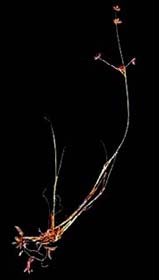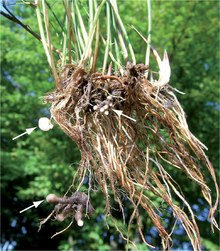Entorrhizomycetes
| Entorrhizomycetes | |
|---|---|

| |
Galls on the roots of Juncus articulatus induced by Entorrhiza casparyana
| |
| Scientific classification | |
| Domain: | Eukaryota |
| Kingdom: | Fungi |
| Clade: | Symbiomycota |
| Subkingdom: | Dikarya Bauer (2015) [2] |
| Division: | Entorrhizomycota Tedersoo, Sánchez-Ramírez, Kõljalg, Bahram, M. Döring, Schigel, T.W. May, M. Ryberg & Abarenkov (2018) |
| Class: | Entorrhizomycetes Begerow, Stoll & R.Bauer (2007)[1]
|
| Type genus | |
C.A.Weber (1884)
| |
| Order | |
| |
| Synonyms | |
|
Entorrhizomycetidae Bauer & Oberwinkler 1997[3] | |
Entorrhizomycetes is the sole
Taxonomy
Taxonomy based on the work of Wijayawardene et al. 2019.[5]
- Order Talbotiomycetales Riess et al. 2015[6]
- Family Talbotiomycetaceae Riess et al. 2015
- Genus Talbotiomyces Vánky, Bauer & Begerow 2007[7]
- Family Talbotiomycetaceae Riess et al. 2015
- Order Entorrhizales Bauer & Oberwinkler 1997
- Family Entorrhizaceae Bauer & Oberwinkler 1997
- Genus Juncorrhiza Riess & Piątek 2019[8]
- Genus Entorrhiza Weber 1884 [Schinzia Nägeli 1842]
- Family Entorrhizaceae Bauer & Oberwinkler 1997
Morphology
All members of Entorrhizomycetes are obligate parasites on the roots of plants.[8] Sori are produced as galls on the roots of hosts. Galls are tubercular with a globoid, irregular or elongated shape and are composed of vascular bundles, parenchymatous cells and fungal mycelium.[7] Younger segments of the galls are pale in color whilst older segments turn brown.[2] Mycelium consists of dikaryotic and septate hyphae with fibrillate walls that lack clamp connections. Initially, the mycelium grows intercellularily before producing coiled intracellular hyphae terminating in globose cells that detach and develop into teliospores.[2] Teliospores germinate into tetrads through internal septation, and each tetrad compartment produce hyphae that terminate in sigmoid propagules.[2] Bauer et al. noted that young teliospores have two nuclei, older teliospores have only one nucleus, and each tetrad compartment has one nucelus each. This indicates that karyogamy and meiosis occurs in the teliospore.[2] It has been observed that teliospores are liberated when the host plant dies and the galls disintegrate,[7] and that the number of galls is higher in waterlogged soils compared to well-drained soils.[9] These observations might support the hypothesis that entorrhizomycetes disperse through soil moisture.[2]


Both Talbotiomyces and Juncorrhiza are segregate taxa from Entorrhiza sensu lato.[7][8] Entorrhiza sensu stricto is diagnosed by teliospores with longitudinally ridged or cerebriform ornamentation and infecting plants belonging to Cyperaceae, whilst Juncorrhiza is diagnosed by teliospores with verrucose-tuberculate ornamentation and infecting plants belonging to Juncaceae.[8] Talbotiomyces is distinguished from species in Entorrhizales by hyphal septa with simple pores that lack caps or membranes (species in Entorrhizales have dolipores that lack caps or membranes) and infecting plants belonging to Caryophyllales.[7][8]
Evolution
Molecular phylogeny place Entorrhizomycetes as either a sister group to
The stem age of the Entorrhizomycota has been estimated to approximately 560 Mya during the late Neoproterozoic era. Divergence between Talbotiomycetales and Entorrhizales is estimated to approximately 50 Mya, and divergence between Entorrhiza and Juncorrhiza is estimated to approximately 42 Mya. Both Entorrhiza and Juncorrhiza underwent a major radiation during the Oligocene and Miocene epochs. Given that these divergence estimates are incongruent or only slightly congruent with the estimated stem ages of the host plant lineages, and incongruence in the co-phylogeny between Entorrhizales and host plants, host-shift speciation is more likely to have occurred than co-speciation during these divergences and the radiation of Entorrhizales.[8]
Entorrhizomycetes have much lower number of species and more limited host range than their estimated age would indicate. One possible explanation is that many lineages have gone extinct along with their hosts during
References
- PMID 17486967.
- ^ PMID 26200112.
- doi:10.1139/b97-842.
- ^ "Subphylum Entorrhizomycotina - Hierarchy - The Taxonomicon". taxonomicon.taxonomy.nl. Retrieved 2023-08-21.
- S2CID 52303619.
- PMID 26203418.
- ^ S2CID 89569780.
- ^ S2CID 59945449.
- doi:10.1139/b83-211.
